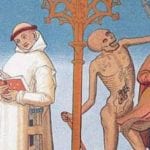 Music
Music  Music
Music  History
History 10 Less Than Jolly Events That Occurred on December 25
 Weird Stuff
Weird Stuff 10 Funny Ways That Researchers Overthink Christmas
 Politics
Politics 10 Political Scandals That Sent Crowds Into the Streets
 Weird Stuff
Weird Stuff Ten Bizarre Facts About The Doge Meme
 Our World
Our World 10 Ways Your Christmas Tree Is More Lit Than You Think
 Movies and TV
Movies and TV The 10 Coolest Stars to Set Sail on The Love Boat
 History
History 10 Things You Didn’t Know About the American National Anthem
 Technology
Technology Top 10 Everyday Tech Buzzwords That Hide a Darker Past
 Humans
Humans 10 Everyday Human Behaviors That Are Actually Survival Instincts
 Music
Music 10 Surprising Origin Stories of Your Favorite Holiday Songs
 History
History 10 Less Than Jolly Events That Occurred on December 25
 Weird Stuff
Weird Stuff 10 Funny Ways That Researchers Overthink Christmas
Who's Behind Listverse?

Jamie Frater
Head Editor
Jamie founded Listverse due to an insatiable desire to share fascinating, obscure, and bizarre facts. He has been a guest speaker on numerous national radio and television stations and is a five time published author.
More About Us Politics
Politics 10 Political Scandals That Sent Crowds Into the Streets
 Weird Stuff
Weird Stuff Ten Bizarre Facts About The Doge Meme
 Our World
Our World 10 Ways Your Christmas Tree Is More Lit Than You Think
 Movies and TV
Movies and TV The 10 Coolest Stars to Set Sail on The Love Boat
 History
History 10 Things You Didn’t Know About the American National Anthem
 Technology
Technology Top 10 Everyday Tech Buzzwords That Hide a Darker Past
 Humans
Humans 10 Everyday Human Behaviors That Are Actually Survival Instincts
10 Bizarre Events in the Age of Reason That Defied Reason
The period from the late 17th century to the close of the Napoleonic Wars is called the Enlightenment—the Age of Reason. It was a period of scientific progress that sought to leave the supernatural behind and explain the workings of the world through natural laws.
There was increasing confidence that there was nothing that couldn’t be explained by reason, logic, and the scientific method. But there are just some oddities then that even today tease the most hardened rationalist and skeptic. There is no escape from the mysterious.
Related: Top 10 Ideas That Were Far Ahead Of Their Time
10 The Russian Fireball of 1663
On August 15, 1663, at the Feast of the Assumption, villagers were gathered at the church in Robozero, Russia. Suddenly, a great noise from above prompted people to rush out to the square. They watched as a giant ball of fire blazed along a north-south trajectory and over a lake.
It was estimated to be 140 feet (43 meters) with two rays emanating in front. It disappeared over the lake but reappeared less than an hour later, moving westward. It disappeared again and returned a third time, having grown in size. People boating on the lake were seared by the heat, and the depths of the lake itself were illuminated by reddish light, scattering the fish.
Was this a natural phenomenon exaggerated by imaginative witnesses? A UFO? Or, as the terrorized people at the time believed, a sign from God? [1]
9 The Father of Psychical Research
As befits a man of the Enlightenment, English philosopher Joseph Glanvill sought to study paranormal phenomena using the scientific method. He called himself a skeptic, not in the sense of disbeliever, but as one who brings rigorous analysis in the examination of supernatural claims. As such, he was acknowledged as the Father of Psychical Research. As a scientist, Glanvill became a member of the Royal Society.
Glanvill’s most famous investigation centered around the poltergeist activity at the Mompesson home in Tedworth, Wiltshire. Mompesson was a magistrate when a vagrant drummer named William Drury was arrested and his drum confiscated. The drum was sent to the Mompesson home for safekeeping. From then on, paranormal activity erupted at the house. The drum began being beaten by phantom hands. Objects were flung around, the children levitated, and mysterious lights appeared. Glanvill himself was witness to some of the phenomena.
Even at the time, many disbelievers in ghosts accused Mompesson of perpetrating a hoax. Glanvill rejected such thinking as dogmatism and less scientific than acknowledging the empirical evidence—in this case, events he could testify to first-hand. Glanvill’s meticulous records and careful observations, written in his book Saducismus Triumphatus (1668), should give us pause that maybe, just maybe, there are more things in heaven and on earth than are dreamt of in our philosophy.[2]
8 The Serpent Creature of the Alps
Ever since the 17th century, sightings of a mysterious, monstrous creature have been reported in the Swiss Alps. The cryptid was first seen in 1711 by Jean Tinner, who shot at it with a musket. In 1779, Hans Fuchs saw two creatures, which he later described as having serpent-like bodies 5 to 7 feet (1.5 to 2.1 meters) long, two front legs with claws, and a head that resembled a cat. Fuchs was so terrified he died of a heart attack soon after. The creature became known as the Tatzelwurm, German for “worm with claws.” It has also been seen in the Alpine regions of Germany, Austria, and Italy.
Some have speculated that the tazelwurm is a giant salamander, but salamanders mostly live in water. Or perhaps it is an evolutionary link between lizards and snakes. Could the deep crevasses of the Alps really be home to a strange beast unknown to science?[3]
7 The Strange Death of Jeanne Lemaire
Early one February morning in 1725, innkeeper Jean Millet of Rheims, France, discovered the smoldering body of his wife Jeanne Lemaire in the kitchen. Except for a few pieces of her anatomy, a strange fire had totally consumed her. Though the floor under the body was charred, a kneading board and salt container near the body were untouched. Authorities quickly concluded that they had a murder on their hands and arrested Millet, who was having an affair with the maid. But he was acquitted at the trial for lack of evidence. So, what really happened to Jeanne?
The famed surgeon of the day, Claude Nicolas Le Cat, believed it was spontaneous human combustion, a rare phenomenon that is as much of a mystery today as it was back then. It appeared to Le Cat that the fire originated from within Mrs. Millet’s body. But whereas in earlier centuries, SHC might have been attributed to demonic forces, Le Cat, imbued by the rational spirit of the age, theorized it to be a result of alcohol consumption and a sedentary lifestyle.
This became the standard explanation and so served as a warning to those addicted to the bottle. Today, we know that the alcohol content of even the most intoxicated person is not enough to cause SHC. What kind of internal fire can entirely devour a body? The puzzle remains.[4]
6 The Vampire Scare of 1732
Johann Fluckinger, an Austrian army doctor sent to investigate claims of vampirism in Medvegia, Serbia, drafted a report that would cause a sensation in Europe. It concerned a man named Arnold Paole, who was alleged to have attacked four villagers after his death and burial. People who opened his coffin were horrified to discover fresh blood flowing from the corpse’s mouth, nose, ears, and eyes.
Convinced that Paole was a vampire, the villagers drove a stake through his heart, after which he screamed and gushed more blood. More villagers suspected of having been attacked by Paole also died, bringing the total death toll to 17. Confirming initial reports, Fluckinger wrote that the victims, too, were found with fresh blood and internal organs intact and healthy as if they were still alive.
Fluckinger could not have been mistaken. He was a battlefield medic thoroughly experienced in cadavers. His report intrigued even the great Enlightenment philosophers Voltaire, Diderot, and Rousseau. It was debated in Parisian salons and may have influenced modern vampire tales like Dracula. Scientists continue to offer theories on the case, but so far, none has yet satisfactorily explained the Fluckinger Report.[5]
5 The Skree of Culloden
On April 16, 1746, the last battle to be fought on British soil was joined at Culloden, Scotland, between the royal Hanoverian forces and the Jacobite army of the pretender Charles Edward Stuart—the Bonnie Prince Charlie. It would be the demise of the Jacobite cause, but even before the battle, premonitions of doom had haunted the rebels.
Visions and ghosts were said to have foretold defeat. But the most horrific was a creature who flew over the Jacobites on the eve of battle, bat-like, with leathery wings and a human head. The Skree, as it was called, was a harbinger of tragedy. Among those who saw it was Lord George Murray, a general not given to flights of the imagination. As the witnesses looked on in shock, the Skree flew off, never to be seen again until the 1990s.
The next day, the weak, starving, and outnumbered Scots were decimated by the government troops, a thousand killed to only 50 of the Redcoats. A thousand more perished in the following days as the Redcoats hunted them down. Bonnie Prince Charlie fled to exile and was never again a threat to the throne.[6]
4 Goethe’s Doppelganger
German novelist and poet Johann Wolfgang von Goethe was in the Alsatian town of Sesenheim one day in 1771 to bid his girlfriend Frederica a final bittersweet farewell. As he rode his horse back toward Druseheim, he saw another horseman approaching from the opposite direction. As he drew closer, Goethe was shaken to see that the man was none other than himself, albeit dressed in an unfamiliar outfit of gray and gold. As Goethe got hold of himself, the figure vanished.
Eight years later, Goethe found himself taking the same road again, but this time toward Alsace to see Frederica. It was then that he realized with a shock that he was wearing the same clothes his ghostly self had appeared in. What Goethe saw was a doppelganger, German for “double-goer,” and a bad omen in folklore. However, Goethe found his vision comforting, as it indicated to him he was on the right path in life.
Modern neurologists theorize that doppelgangers have something to do with how the brain constructs an awareness of the self and that people with a condition called autoscopy are more likely to hallucinate images of themselves.[7]
3 Mass Hysteria at the Cotton Mill
A young girl at a Lancashire cotton mill decided to prank a fellow worker with a mouse one day in February of 1787. It scared the victim out of her wits, and she had a convulsive fit that lasted for hours. The next day, three more girls were similarly affected. Monday morning saw 24 people—including a man—having severe, violent attacks, some so bad they tried to beat their heads against the wall. The factory had to shut down, and suspicion that a dreaded disease—perhaps the plague—had invaded the mill. A doctor was called in and soon discovered that applying an electric shock to the victims ended their convulsions.
While mass hysteria remains a strange and terrifying phenomenon, psychologists have come to understand that stress might be a trigger and groupthink the psychological vehicle of transmitting the illness.[8]
2 Phantom Artillery of the Rockies
Meriwether Lewis and William Clark reached the Rockies in July 1805, a year and two months into their epic exploration of the American West. In those mountains, Lewis wrote of hearing mysterious sounds “as loud and resembling precisely the discharge of a piece of ordinance of 6 pounds at the distance of three miles.”
The explorers recalled that similar sounds were heard in the Black Hills of South Dakota among the Pawnees and Arikaras, which they dismissed as superstitious imaginings. But now, hearing the phenomenon themselves, they were baffled. The clear skies precluded thunder, and there were no avalanches.
Travelers to the region continued to hear the sounds in subsequent years. It was noted that a similar phenomenon had been attested to in diverse places like Canada, the UK, Brazil, and Bangladesh, where it is called Barisal Guns. As recently as the late 1970s, 600 “mystery booms” were heard along the East Coast, evoking such fear that a Congressional investigation was launched. It couldn’t find any known cause for one-third of the cases. Theories proposed throughout the years range from subterranean energy waves to sound reflectance or lensing.[9]
1 The Assassination of Spencer Perceval
On the morning of May 2, 1812, John Williams, a mine manager from Cornwall, awoke from a disturbing dream. Three times during the night, he saw himself in the lobby of the House of Commons, where a small man in a blue coat and a white waistcoat came hurrying in. Another man in a brown suit with gold buttons suddenly sprang forward with a pistol aimed at the small man. The bullet hit him in the chest, and he fell mortally wounded as onlookers took down the assassin. Williams asked for the victim’s identity and was told that he was Spencer Perceval, the Prime Minister.
Williams’s wife dismissed the dream, and his friends dissuaded him from warning the PM, as he might be taken for a lunatic. Williams scanned the papers in the succeeding days for any report. On the 13th, his son burst in with the news: the PM had been fatally shot in the lobby of the Commons on the 11th by a man named John Bellingham. Every detail happened exactly as Williams dreamed it, down to the attire of the victim and killer.
Even stranger, there was no personal connection between Williams and either Perceval or Bellingham. Spencer Perceval is the only British Prime Minister to be assassinated.[10]








